What your sleep position says about your relationship
At some point in our lives, we may share a bed with a partner. Some may see this as an act of intimacy, for others it may cause discomfort and have a negative effect on our sleep. Research has revealed that over 40% of women in relationships would rather sleep alone than with their partner.
We’ve taken a deep dive into some of the most popular sleep positions, from the famous spoon to the lesser-known cliffhanger. Through enlisting the help of leading relationship psychologist Mairead Molloy at Berkeley, we’ve revealed what your favourite positions might reveal about your relationship.
1. Spooning

Spooning is one of the most widely known and popular couple’s sleeping positions. It involves both partners lying on their sides, facing the same way with one person acting as the “big spoon,” cocooning the other “small spoon” in a sideways hug.
Mairead says oxytocin, affectionately known as the cuddle chemical or love hormone, is said to release when two people spoon, as well as dopamine and serotonin. The hormone oxytocin can promote bonding and is associated with a number of other benefits, including pain and stress relief.
When it comes to the health of your relationship, Mairead states if you and your partner sleep in this position it means you see eye-to-eye. Couples who spoon are merging their bodies together as one, so you may see them doing lots of the same things together.
2. Chasing Spoon
Chasing spoon is a variation of spooning. In this sleep position, one partner sleeps on one side of the bed, and the other ‘chase them’ across the bed.
Mairead tells us this could mean one of two things, either the partner being chased likes to play hard to get, or they are retreating and want more space from their “chaser”.
This might also be a sign that their needs aren’t being met. The “chaser” could also be wanting more attention from their partner.
3. Loose Spoon
Rather than being hugged tight as you would in the traditional spooning position, a loose spoon sees you and your partner keep a small distance between you both, allowing you to move around as you sleep. This variation of the spoon is favoured during warmer months when you want to be intimate but not overheat by being too close.
Couples who sleep in this position have more than likely been together long enough to feel a strong level of trust without needing the reassurance of constant touch, Mairead explains.
If you’re the big spoon, this position essentially means that you can be counted on at any time, but you know that you and your little spoon like the extra comfort that comes with giving each other a little space.
4. Back-to-Back
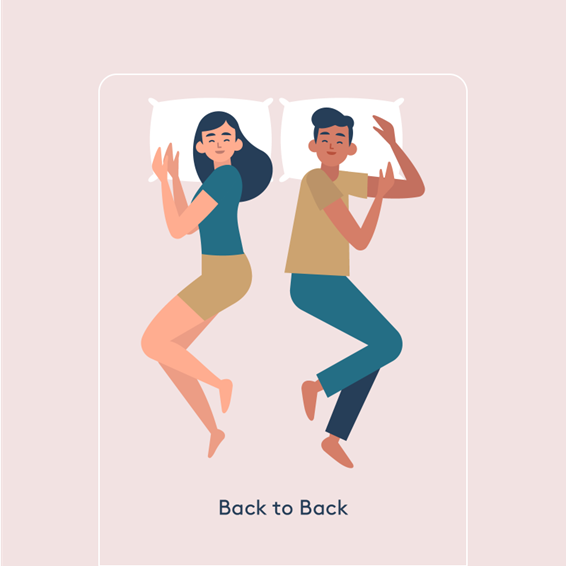
When sleeping back-to-back, both members of the couple lie on their sides but face opposite directions.
According to Mairead, those who fall asleep with contact along the spine show a balance of closeness and independence.
If your bottoms touch — also called “moon landing,” it means you both want to stay sexually connected while still feeling comfortable facing away from each other.
If you prefer this position, chances are you are very comfortable and relaxed with each other. The two of you might have also fought recently, but your willingness to touch means the relationship is still okay.
5. Intertwined

This position is also called the lovers’ knot and is an intimate sleeping position that involves both partners sleeping face-to-face in a close embrace, with their legs intertwined.
This position may become uncomfortable and result in dead limbs. Many couples therefore only stay in this position for the first few minutes of sleep before adjusting to a more comfortable position.
Being fully intertwined with a lover is an incredibly close and romantic position, says Mairead. This position is popular among new couples, and can sometimes be a transitory pose before or after a couple has intimacy.
If you and your partner just started dating, this position screams young love between the two of you. Some couples maintain this throughout their relationship, but this can potentially signify that these two individuals are dependent on each other.
6. Front-to-Front
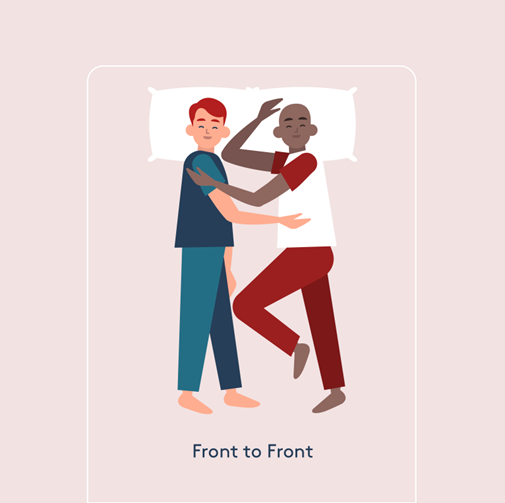
A slight variation on being fully intertwined but perhaps less uncomfortable. Front-to-front sees both partners face each other with their heads at the same level. You may be slightly touching with both arms draped across each other.
This intimate position communicates that you and your partner are like-minded and there is a good overall atmosphere in the relationship explains Mairead.
7. Cliffhanger
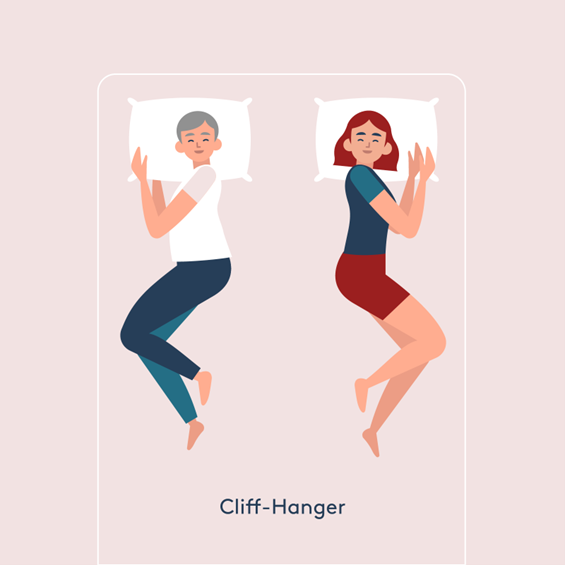
When both partners are sleeping on opposite sides of the bed, as far away as possible from each other, they’re doing the ‘cliffhanger’.
One of you may have a foot sticking out over the edge. Although to most people, this could be a sign that there’s a real problem in the relationship. However, Mairead suggests, if this position is not carried out aggressively, it can actually signify that both people are happy with themselves and with their partner.
8. Head on shoulder
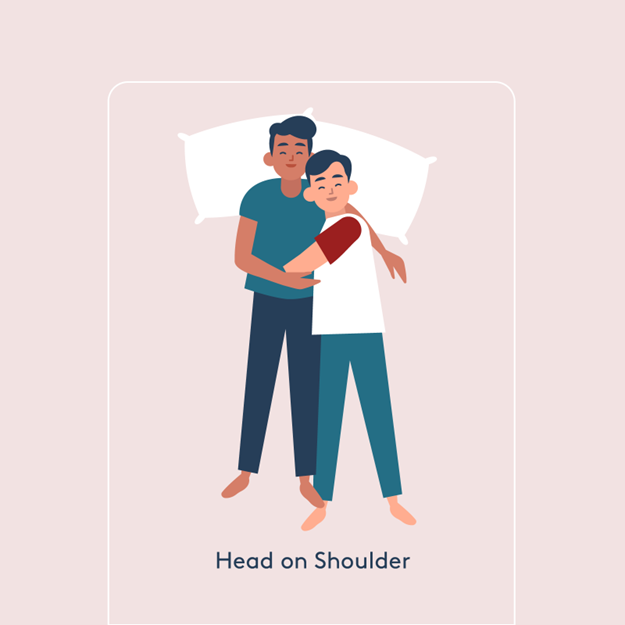
Head on shoulder, also known as the “shingles” position, sees both you and your partner sleeping on your backs, with one partner resting his or her head on the other’s shoulder.
Mairead says that this position shows a high level of comradeship, where one partner allows the other to play “protector” and nurture them.
This position indicates there is a lot of understanding and confidence in the relationship.
Couples may find themselves gravitating towards this position when there is a lot of stress in their lives, and need their partner to hold them close to help them feel safe and protected.
9. Sweetheart Cradle
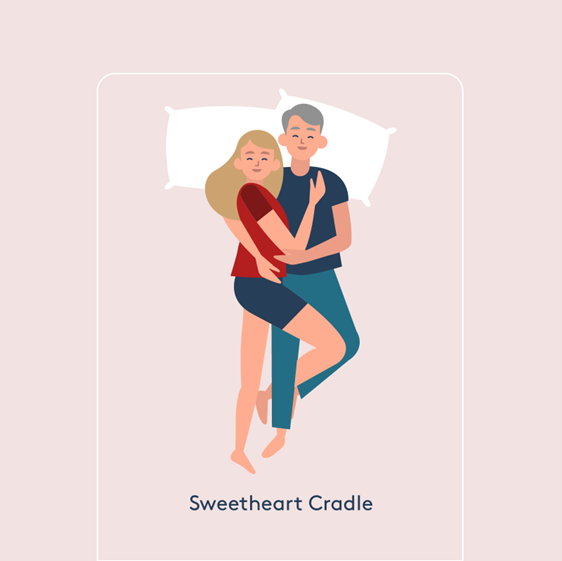
This sweet, nurturing posture has one partner resting their head on the other partner’s chest, with their legs intertwined as they hold each other close.
A couple who prefers this sleep position has a high level of trust and teamwork between them.
This snuggling position shows protection and romance and is favoured by many new couples or those who have rekindled their romance.
10. Leg Hug
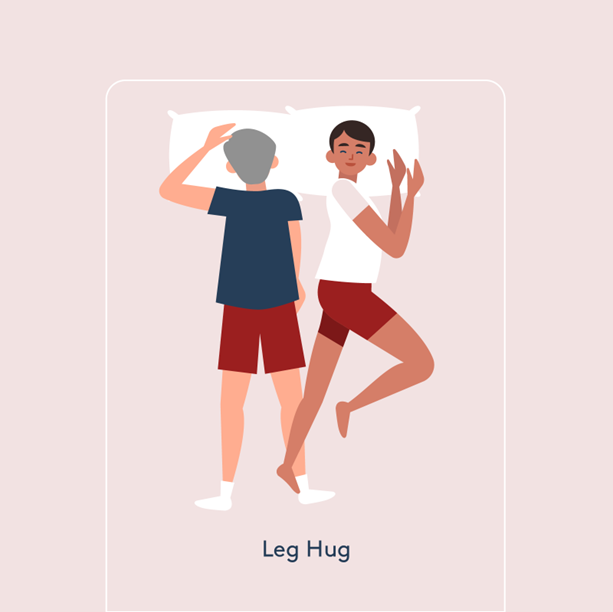
Leg hug is one of the most comfortable co-sleeping positions which shows independence as well as passion. Leg hug position involves the couple choosing their own comfortable sleep position (whether that be on their front, back or side) but having a leg or foot touching their partner.
Mairead suggests this sleep position shows that you are in a comfortable relationship but could mean that the person is craving a sexual or emotional connection.
A pair of tangled legs shows that your lives are intertwined and that you exist as a unit.
11. Space Hogger

The space hogger position has one partner assuming the “starfish”, where he or she is sprawled out and taking up the majority of the mattress while their partner takes a secondary role.
If the starfish partner begins to push their partner off, it is an indicator that they are selfish in the relationship Mairead expresses.
In addition, if one partner both takes up space and places themselves higher than the other, they tend to see themselves as more dominant and confident.
If this is the position you and your other half always find yourselves in, Mairead suggests it may be good for you to have a frank conversation about the power dynamic in their relationship.
12. Pet/Child Barrier
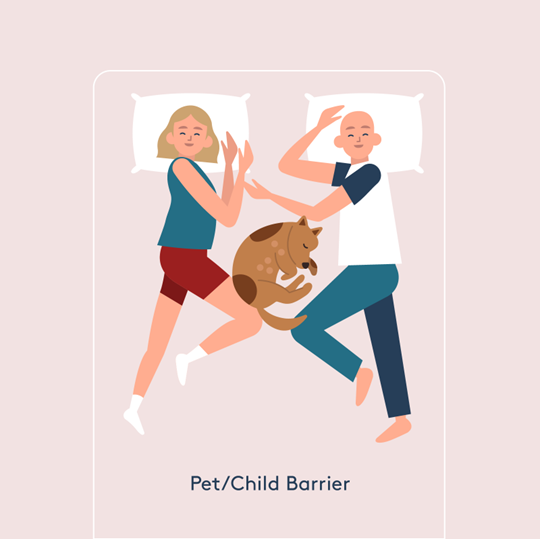
Sharing a bed with your dog or cat is becoming increasingly common these days. For some couples, placing a pet in between them can serve as a way to get some extra space at night as well as reinforce the strong bond between you and your pet.
However, it might also mean that the two of you are avoiding something in your relationship.
Perhaps you may want to consider talking with your partner or consider getting a separate dog bed.
Could a sleep divorce save your relationship?
No one talks about sleep divorce and it is so common Mairead explained. A sleep divorce is simply sleeping apart, in separate beds or bedrooms so that both partners can get the best sleep.
If your partner snores, moves a lot or gets up in the middle of the night, you wake up. Naturally, this interrupts your rest. This takes a toll on you both physically and psychologically and could lead to a whole host of problems including sadness, mood swings, a lack of concentration and even weight gain.
Sleeping in another room helps not only improve your comfort and rest but also to keep your personal space. Mairead explains how a sleep divorce caneven encourage sexual relations with your partner. Being separated at night favours the existence of an erotic space in which you miss the other person. Thus, it increases your desire to be together.
If you’re a very romantic person and are horrified by the idea of spending the night alone, an intermediate solution could be sleeping in the same bed but with separate duvets or blankets. This is known as the Scandinavian sleep method or Swedish sleep method. Overall, this is a good way to sleep together but still comfortable if your partner moves a lot and invades your space.
There are many different ways to sleep as a couple in a relationship – together and separately, you just need to find what works for you. You can still be happy and in love.
Expert tips to deal with a partner who snores
If your issues with sleeping next to someone is due to snoring, Dr Lindsay Browning, neuroscientist and sleep expert has shared her tips on how to cope with a partner who snores:
1. Encourage a different sleeping position
Often snoring is worse when somebody sleeps on their back. Therefore, making sure your partner is sleeping on their side can help to minimise snoring. If they wake you up and they are on their back, give them a gentle nudge or tap to encourage them to sleep on their side instead.
2. Support a lifestyle change
Snoring is commonly worse when someone has drunk a lot of alcohol or if they are overweight. Reducing alcohol consumption and losing some weight can reduce or even prevent snoring altogether. Try a healthier lifestyle together so as to not make it seem like you are ganging up on them.
3. Remove potential allergens
If your partner suffers from nighttime congestion it may be that they are allergic to the feathers in your pillows or the dog in your bed. Changing your pillows, having the dog sleep on the floor or in another room, or taking an antihistamine may help to reduce their snoring.
4. Ask them to see their GP
If you notice your partner's snoring is broken by pauses and breathing during the night, then this is indicative of obstructive sleep apnoea. Sleep apnoea is where your throat closes up during the night so much that the airway is completely blocked and air cannot flow at all. After a while of not breathing, your brain will realise and send a surge of adrenaline to wake you up in order for you to breathe again, and then you will likely fall straight back to sleep. Often, people will fall back to sleep again so quickly that they will not realise they woke up at all, but their sleep quality will have been damaged by this disruption.
In sleep apnoea, these awakenings can happen repeatedly through the night causing both you and your partner to have significantly disrupted sleep. Other signs of sleep apnoea are that they may wake with a choking sensation or may feel chronically tired during the daytime, despite the fact that they thought they got sufficient sleep at night. If you suspect your partner may have sleep apnoea then it is very important that they speak to a GP about the snoring, because there are significant health implications to untreated sleep apnoea.
- 7th February 2023


